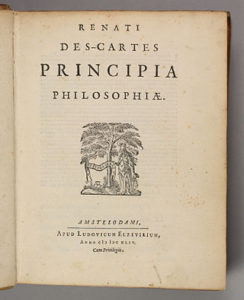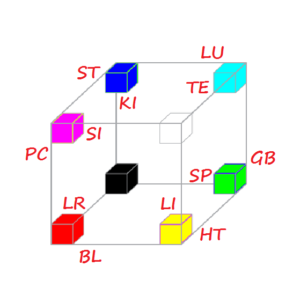Descartes’ physics is a description of the properties of three-dimensional space. The demiurges who created our civilization left evidence of the fact of creation.
The very fantastic name – Rene Descartes (Renati Des-Cartes) is translated into an encrypted message – “Reviving This World”:

- from “Ren, renati” arose the name of the kidneys in medicine, which also in Chinese philosophy are the source and guardian of life,
- “Des” is a pointer to something,
- “Cartes” – a map, a quadrangle, a square, a quarter – a manifestation of the quadrants of the three planes of the three-dimensional world, dividing space into 8 parts – octants.
Therefore, the fact that the 8 parts of the whole in Spain and the Middle East were called real (rial) – something that has real value and integrity, takes on special meaning. Reality is what is defined in our physical world by three-dimensional Space.
From a physical point of view, any object – take an ant or take our star named the Sun – in the boundless space of the Universe can be represented by a simple point. The infinity of the surrounding space will equalize the applicability of the same model to both objects under consideration.
This philosophy leads us to the fact that any point object in three-dimensional space can also be represented by an elementary cube. The elementary cube is the “assemblage point” (according to Carlos Castaneda) of the object under study in a rectangular Cartesian coordinate system, the center of which is inside the object.
How can we characterize an elementary cube? It has:
8 vertices,
6 faces,
12 edges.
If a reader who is familiar with the Chinese theories of Ba-Gua, 6 Qi and 12 meridians suddenly has a vague suspicion, then I think he will be right.
It is the model of an elementary cube that underlies the description of any processes in the body through the scheme of movement of universal energy – Qi, and in fact – a complex of laminar and vortex movement of the world’s Aether – a substance that fills space and creates with its vortices all known material particles and effects found and studied by modern physics.
Let us describe the properties of an elementary cube in relation to the theories of Chinese philosophy.
Each part of the cube has certain properties that are closely related to the structure of the RGB color model in science and technology. From this point of view, each vertex of the cube has certain natural frequencies, which are shown in the figure in different colors.

Meridians, as conductors of vibrational energy, are located on the edges of the cube and this arrangement is dictated by the Doppler model of the theory of the Five Elements.
https://www.researchgate.net/publication/309956054_The_Elements_of_life
In the Doppler model, 12 meridians are grouped in pairs for each of the 6 types of vibration (Qi). In this case, 6 types of vibrations are received in correspondence with Yin and Yang meridians. Yin and Yang meridians of the same color (bands of the vibration spectrum) are adjacent edges of an elementary cube.
The vertice of the small white cube is a source of energy that moves towards the vertice with black (the “black hole” absorbing energy).
Moreover, if each pair of meridians of the same color conducts energy in the direction from the Yang meridian in the direction of the Yin meridian:
Small intestine (SI) – Pericardium (PC),
Bladder (BL) – Liver (LR),
Large intestine (LI) – Heart (HT),
Gallbladder (GB) – Pancreas (SP),
Triple heater (TE) – Lungs (LU),
Stomach (ST) – Kidneys (KI).
Then, on each face of the cube, a counterclockwise Qi circulation is formed, when viewed towards its center. This causes the movement of electrons from inside the body towards the surface, which corresponds to the predominance of the catabolic phase of metabolism.
The white vertice of the cube, as a source of energy, is depleted over time, and the black one, due to the elastic properties of the ether, produces an accumulation of energy, which leads to a reverse current of the Aether. Those. a cyclical process of energy exchange between the polarities of the dipole arises, in fact reflecting the continuous oscillatory process of the predominance of Yin or Yang in each vertex of the cube.
The positions of the meridians on the edges of the elementary cube confirm the scheme of the daily circulation of the meridian activity from the point of view of midnight-noon.
It is also clear that the division of the meridians into a group of centripetal and centrifugal meridians becomes clear:
The centripetal meridians SI-LR-LI-SP-TE-KI form the concentration of energy either Yang or Yin, depending on which phase of metabolism prevails at a given time.
The centrifugal meridians PC-BL-HT-GB-LU-ST organize solenoid circulation around the axis connecting Yin and Yang of the vertex of the elementary cube.
From the point of view of electrical engineering, it can be argued that the centripetal system of meridians predominantly has the properties of a capacitor, and the centrifugal system of meridians serves mainly as a solenoid in a single oscillatory system of the body. Then it would be appropriate to consider the organism as an oscillatory circuit, the properties of which can be described by the Q-factor formula:

Parameter Pd is dissipated power, which reduces the total vibrational energy which depends on the degree of mutual desynchronization of 12 meridians functionality in the body. Those. in the form of a quality factor dependent on the state of 12 meridians, we get a universal concept of the health of an organism from a physical point of view. It follows from this that recovery objectively depends solely on the synchronization of 12 meridians, and any other approach is incomplete and, accordingly, random in terms of obtaining a result in the form of recovery.
Management of the state of the meridians with the help of the minerals of Dr. Alexander Samokhotskiy allows maintaining the meridians in balance with minimal means and minimal impact.

Leave a Reply